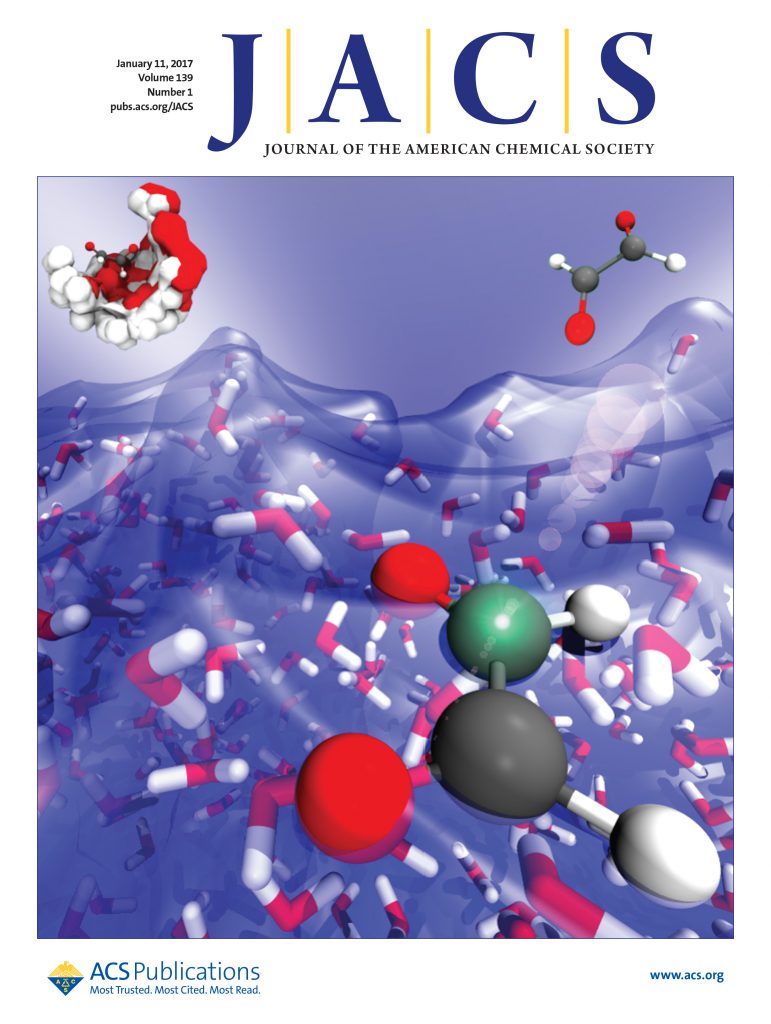肽天然产物生物合成中天门冬氨酸转化为氨基丙酸的两步酶级联反应的发现
IF 15.6
1区 化学
Q1 CHEMISTRY, MULTIDISCIPLINARY
引用次数: 0
摘要
氨基酸丙二酸(Ama)存在于多种生物的天然产物和蛋白质水解物中,但对其生物合成来源的了解仍然有限。通过利用核糖体合成和翻译后修饰肽(RiPPs)的生物合成基因簇,我们确定了Ama生物合成的新双酶途径。RiPPs是新酶化学的丰富来源。这一生物合成途径由铁(II)/2-氧戊二酸依赖的加氧酶(Fe(II)/2OG)、SmaO和非典型铁(II)依赖的组氨酸-天冬氨酸(HD)结构域酶SmaX介导,将天冬氨酸(Asp)转化为中间产物β-羟基天冬氨酸(Hya),最终转化为Ama。这些串联酶促反应──酸官能团旁边的碳的羟基化和α-羟基酸中随后的四电子氧化键裂解──与其他已知的HD结构域加氧酶PhnZ和TmpB类似。然而,SmaX也表现出独特的特征,例如α-羟基羧酸盐中C-C键的切割使用单个Fe辅助因子,而PhnZ和TmpB中C-P键的切割使用混合价双铁辅助因子。生物信息学分析表明,这种双酶级联可能存在于多种肽天然产物的生物合成途径中,包括RiPPs和非核糖体肽(nrp)。总之,我们的研究证明了一种新的Ama生物合成途径的存在,并表明其在肽天然产物生物合成中的广泛分布。本文章由计算机程序翻译,如有差异,请以英文原文为准。

Discovery of a Two-Step Enzyme Cascade Converting Aspartate to Aminomalonate in Peptide Natural Product Biosynthesis
Aminomalonic acid (Ama) is found in various natural products and protein hydrolysates of multiple organisms, but the understanding of its biosynthetic origin remains largely limited. By exploiting a biosynthetic gene cluster for ribosomally synthesized and post–translationally modified peptides (RiPPs), which are rich sources of new enzyme chemistry, we identified a novel two-enzyme pathway for Ama biosynthesis. This biosynthetic pathway, mediated by an Fe(II)/2-oxoglutarate-dependent oxygenase (Fe(II)/2OG), SmaO, and an atypical Fe(II)-dependent histidine-aspartate (HD) domain enzyme, SmaX, converts aspartate (Asp) to β-hydroxyaspartic acid (Hya) intermediate and ultimately to Ama. These tandem enzymatic reactions─hydroxylation of the carbon next to an acid functional group and subsequent four-electron oxidative bond cleavage in α-hydroxy acid─are similar to those associated with other known HD domain oxygenases, PhnZ and TmpB. However, SmaX also exhibits unique features, such as C–C bond cleavage in α-hydroxycarboxylate using a single Fe cofactor, in contrast to the C–P bond cleavage using a mixed-valent diiron cofactor in PhnZ and TmpB. Bioinformatic analysis reveals that this two-enzyme cascade may be present in various biosynthetic pathways for peptide natural products, including RiPPs and nonribosomal peptides (NRPs). Collectively, our study demonstrates the presence of a novel Ama biosynthetic pathway and suggests its widespread distribution in peptide natural product biosynthesis.
求助全文
通过发布文献求助,成功后即可免费获取论文全文。
去求助
来源期刊
CiteScore
24.40
自引率
6.00%
发文量
2398
审稿时长
1.6 months
期刊介绍:
The flagship journal of the American Chemical Society, known as the Journal of the American Chemical Society (JACS), has been a prestigious publication since its establishment in 1879. It holds a preeminent position in the field of chemistry and related interdisciplinary sciences. JACS is committed to disseminating cutting-edge research papers, covering a wide range of topics, and encompasses approximately 19,000 pages of Articles, Communications, and Perspectives annually. With a weekly publication frequency, JACS plays a vital role in advancing the field of chemistry by providing essential research.

 求助内容:
求助内容: 应助结果提醒方式:
应助结果提醒方式:


